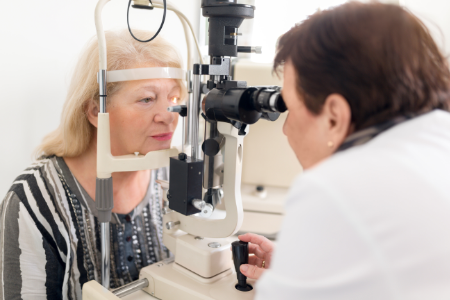- What causes glaucoma?

- What happens if you have glaucoma?
- How do you get glaucoma?
- What are the symptoms of glaucoma?
- How is glaucoma treated?
- Can I prevent glaucoma?
Unfortunately, about one-half of the people in the world with glaucoma have yet to be diagnosed. This condition is the second-leading cause of blindness globally. While there is no cure for glaucoma, if it’s discovered early on, we can control its progression and your symptoms so that you don’t lose your vision completely.
If you’re curious about glaucoma or worried about the health of your eyes, this blog is for you.
What Causes Glaucoma?
Glaucoma is caused by higher-than-normal eye pressure that eventually damages the optic nerve. Doctors aren’t certain exactly why the higher pressure damages the eye; we just know that glaucoma happens when there is a fluid buildup in the eye that increases the pressure.
There are several types of glaucoma, including:
- Angle-closure, which is caused by a blockage in the drainage canals of the eye
- Congenital, which occurs in babies as a birth defect
- Normal-tension, which is also called normal-pressure or low-tension glaucoma
- Open-angle, which accounts for 90% of all cases
There are also variants of angle-closure and open-angle glaucoma, such as secondary glaucoma, which occurs as a direct result of a primary cause such as advanced diabetes or cataracts.
What Happens if You Have Glaucoma?

During glaucoma, the optic nerve becomes damaged from high intraocular pressure. As the nerve disintegrates, blind spots in your field of vision begin to form. If not treated, those blind spots can expand into true blindness.
The eye is both delicate and complex. The tissues stay moist with a steady, regulated flow of fluid called aqueous humor circulating inside the eye. Normally this internal fluid drains out through the trabecular meshwork at the corner of the eye. However, if this drainage system is disrupted, fluid can build up and increase eye pressure.
How Do You Get Glaucoma?
Glaucoma tends to run in families, but it also seems to increase in those over the age of 60. Glaucoma is a condition that happens on its own and it isn’t contagious. You may be at higher risk if you are Hispanic or Asian. However, other physical conditions seem to be linked to glaucoma development, including:
- Diabetes
- Heart disease
- High blood pressure
- Sickle cell anemia
You may be more prone to glaucoma based on how your eye is structured. If you have thin corneas or are highly farsighted or nearsighted, you may have an increased risk. There is also evidence that prolonged use of corticosteroids over time can cause the spike in intraocular pressure that can lead to glaucoma.
What Are the Symptoms of Glaucoma?
If you have open-angle glaucoma, you may not have any symptoms at all. Symptoms don’t develop in this type of glaucoma often until the later stages of the disease. As a result, glaucoma can gradually erode your eyesight without you even being aware at first.
Angle-closure glaucoma comes on faster, and the symptoms are more obvious. With this type of glaucoma, you may experience the following:
- Eye redness
- Hazy-looking eyes
- Pain in your eyes
- Seeing halos around lights, especially at night
- Vision loss
- Vomiting or an upset stomach
Your eye doctor will screen regularly for glaucoma, which is why regular eye exams are so important. Checkups are painless and very effective at diagnosing the condition.
How Is Glaucoma Treated?

Typically, eye drops or oral medications are prescribed to treat glaucoma. In some cases, laser surgery may be indicated. However, glaucoma treatment depends on the type of condition that you have. Your doctor will conduct several tests to determine the level of intraocular pressure and the type of glaucoma you have. These tests could include:
- A dilated eye exam and imaging tests to look for optic nerve damage
- Gonioscopy to inspect how the eyes are draining
- Pachymetry to measure the thickness of your cornea
- A tonometry test to determine your intraocular pressure
- Visual field tests to see if you’ve lost areas of your vision
These diagnostic measures will help your doctor figure out what types of eyedrops to prescribe. The medications you receive could be any combination of the following:
- Alpha-adrenergic agonists slow fluid production and increase the outflow
- Beta-blockers slow down fluid production in the eye
- Carbonic anhydrase inhibitors also slow fluid production
- Miotic or cholinergic agents increase fluid production
- Prostaglandins to increase the aqueous humor flowing in your eyes to reduce pressure
- Rho-kinase inhibitor helps lower pressure by supporting the enzymes that stimulate fluid production
You may also be prescribed oral medication, particularly if the eyedrops by themselves are not reducing the pressure. As a last resort, your doctor may recommend surgery, such as:
- Drainage tubes may be inserted into your eyes
- Filtering surgery actually removes some of the clogged eye meshwork
- Laser therapy can work well to unclog drainage channels if you have open-angle glaucoma
Can I Prevent Glaucoma?
The number one way to prevent glaucoma is to see your eye doctor annually to screen for the disease. Regular comprehensive eye exams can detect glaucoma early on before the optic nerve is damaged and vision is lost.
Currently, it is recommended that you seek out these exams at particular stages in your life:
- If you are under the age of 40, it’s recommended to have an eye exam every five to 10 years
- If you are 40 to 54, have an eye exam every one to three years
- If you are 55 to 64, an eye exam should occur every one to three years
- If you are over 65, it’s important to have an annual exam
Since glaucoma can be genetically inherited, it’s important to know your family history of the disease. You can also help prevent glaucoma by:
- Exercising regularly, which has shown to reduce pressure in your eyes
- Wearing eye protection, especially if you play sports
- Using preventative glaucoma eye drops prescribed by your doctor, particularly if you have a family history with glaucoma
Interestingly, some vitamins are marketed as “eye vitamins,” although there is very little evidence supporting eye vitamins as glaucoma preventatives. Some studies do suggest a diet high in vitamin B, which you can obtain by eating green leafy vegetables, may help prevent glaucoma.
If you’re worried about your eye health, the time is now to call our team to establish regular preventative visits to care for your vision. Glaucoma can be successfully treated—all you need to do is give us a call.

